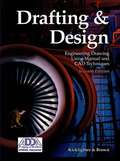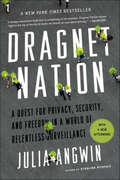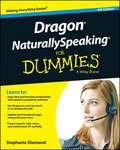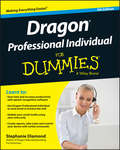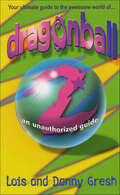- Table View
- List View
Drafting and Design: Engineering Drawing Using Manual and CAD Techniques
by Clois E. Kicklighter Walter C. BrownWritten to meet the educational needs of both beginning and advanced students, Drafting & Design features comprehensive instruction in both manual (traditional) drafting and computer-aided drafting (CAD). Step-by-step, detailed drafting procedures are presented throughout the text to illustrate the tools and techniques of both methods. For each drafting task presented, manual and CAD procedures are given in sequence to explain both approaches to drafting.
Dragnet Nation: A Quest for Privacy, Security, and Freedom in a World of Relentless Surveillance
by Julia AngwinAn inside look at who's watching you, what they know and why it matters. We are being watched.We see online ads from websites we've visited, long after we've moved on to other interests. Our smartphones and cars transmit our location, enabling us to know what's in the neighborhood but also enabling others to track us. And the federal government, we recently learned, has been conducting a massive data-gathering surveillance operation across the Internet and on our phone lines.In Dragnet Nation, award-winning investigative journalist Julia Angwin reports from the front lines of America's surveillance economy, offering a revelatory and unsettling look at how the government, private companies, and even criminals use technology to indiscriminately sweep up vast amounts of our personal data. In a world where we can be watched in our own homes, where we can no longer keep secrets, and where we can be impersonated, financially manipulated, or even placed in a police lineup, Angwin argues that the greatest long-term danger is that we start to internalize the surveillance and censor our words and thoughts, until we lose the very freedom that makes us unique individuals. Appalled at such a prospect, Angwin conducts a series of experiments to try to protect herself, ranging from quitting Google to carrying a "burner" phone, showing how difficult it is for an average citizen to resist the dragnets' reach.Her book is a cautionary tale for all of us, with profound implications for our values, our society, and our very selves.
Dragon Age Omnibus
by VariousBioWare&’s best-selling franchise Dragon Age lives on in these canonical comics from Dark Horse—now in an affordable omnibus format! Dragon Age lead writer David Gaider pens an exciting tale following King Alistair as he discovers the fate of his father. Collects Dragon Age miniseries The Silent Grove, Those Who Speak, and Until We Sleep. * Written by Dragon Age lead writer David Gaider! * Now available in an affordable paperback omnibus!
Dragon Age Volume 1: The Silent Grove (Dragon Age)
by David GaiderDragon Age: The Silent Grove is the perfect introduction to BioWare's dark fantasy universe! In this essential, canonical story from David Gaider, lead writer of the games, King Alistair, accompanied only by rogues Isabela and Varric, embarks on a quest deep inside the borders of Antiva—a nation of assassins! Together, they will encounter a prison break, dragons, the mysterious Witch of the Wilds, and one of the greatest secrets in the history of the world!* Story by David Gaider, lead writer of the Dragon Age games and novels!* Collecting Dragon Age #1–#6!
Dragon Age Volume 2: Those Who Speak (Dragon Age)
by David GaiderDragon Age Lead Writer David Gaider brings his newest epic to a revealing conclusion! With her dark past laid bare, the pirate Isabela must resolve to escape this dungeon or lose herself forever, even as King Alistair must take up arms against an old ally if he is to have any hope of uncovering the fate of his father! * Story by David Gaider, lead writer of Dragon Age: Origins and Dragon Age II!
Dragon Age Volume 3: Until We Sleep (Dragon Age)
by David GaiderThe lead writer of BioWare's hit Dragon Age games concludes King Alistair's epic quest—in a journey beyond reality itself! Fans around the world have recognized the Dragon Age comics to be an integral addition to the video-game saga. Now, series writer David Gaider pits King Alistair and his noble companions Varric and Isabela against their most nefarious foe—the twisted blood mage Aurelian Titus! An essential read while you wait for Dragon Age III! from Dragon Age lead writer DAVID GAIDER!
Dragon Age: Blue Wraith
by Christina Weir Nunzio DeFilippisA group of Inquisition agents pursue the deadly elven warrior Fenris in this new chapter from the world of BioWare's dark fantasy RPG!From the video game developer of genre-defining roleplaying games such as Baldur's Gate, Star Wars: Knights of the Old Republic, and Mass Effect comes a canonical continuation of stories begun in the multiple game of the year award-winning Dragon Age: Inquisition.The power of the substance known as red lyrium is as dark as it is devastating, and a mysterious weapon containing a frightening amount of it is about to fall into the wrong hands. Enter knight Ser Aaron Hawthorne, elven thief Vaea, the magekillers Tessa Forsythia and Marius, and fledgling con artist Calix Pryde--a motley team of Inquisition agents whose task it is to recover the lyrium artifact before it's too late. In order to do so, fellow agent Varric Tethras directs them to recruit one more to their party, a former associate from Kirkwall--Fenris. However, as the team quickly discovers, this legendary fighter has an agenda of his own, and convincing him to join their cause will be no small feat.Collects Dragon Age: Blue Wraith #1-#3.
Dragon Age: Deception
by Christina Weir Nunzio DeFilippisBioWare's bestselling fantasy franchise lives on in these canonical comics from Dark Horse!Olivia Pryde hasn't worked an honest day in years. Once an actress, she now lives by the con, and has come to Tevinter with a new target: Calix Qintara, the heir to a wealthy house. Once she approaches the young man, she quickly realizes that he is not exactly who he says he is--and she may be in too deep. This version collects Dragon Age: Deception #1-#3.
Dragon Age: Hard in Hightown
by Various Varric Tethras Mary KirbyProlific dwarven author and heroic companion of the Dragon Age games, Varric Tethras brings us the collected edition of his breakthrough crime-noir drama, Hard in Hightown (with help from his trusted human confidante, Mary Kirby)! This volume is beautifully illustrated by Stefano Martino, Álvaro Sarraseca, Andres Ponce, and Ricardo German Ponce Torres, with a painted cover by E.M. Gist!Twenty years of patrols have chiseled each and every stone of the Kirkwall streets into city guardsmen Donnen Brennokovic. Weary and weathered, Donnen is paired with a recruit so green he might as well have leaves growing out of his armor. When the mismatched pair discover a dead magistrate bleeding out on the flagstones, they're caught up in a clash between a shadowy organization known only as the Executors and a secretive group of Chantry agents--all over some ancient artifact.This is a prose novel featuring 24 black And white full page images.
Dragon Age: Knight Errant
by Christina Weir Nunzio DeFilippisBioWare's bestselling fantasy franchise, Dragon Age, lives on in these canonical comics from Dark Horse!Vaea, an elven squire, and her knight, the drunken Ser Aaron Hawthorne, arrive in Kirkwall just in time for Varric Tethras' appointment as Viscount. A talented thief, Vaea skips the party to take on an easy job recovering a hidden lock box . . . but when she chooses to change the terms of the deal mid-heist, she is entangled in a dangerous mission that is surely above her pay grade.Collects the comic series Dragon Age: Knight Errant, Issues #1-5
Dragon Age: Magekiller
by Various&“Dragon Age: Magekiller is a fun and engaging fantasy story for anyone who enjoys the genre.&”—Comic Book ResourcesTessa and Marius are mercenary partners who eliminate those that use magic to hurt others. When they betray a powerful patron intending to kill them, they&’re forced to flee and join the Inquisition. Collects issues #1–#5 of the miniseries.
Dragon Age: The First Five Graphic Novels
by Greg Rucka Christina Weir Alexander Freed David Gaider Nunzio DeFilippisIn Bioware's dark fantasy world of Thedas there are those who are willing to sacrifice their humanity for wealth and power, and those who will die to protect innocent people from them.The heroes of Thedas are often from unlikely places, some are pulled in to save the day by an odd string of fate, others seek adventure out on their own. These are their stories. The lonely king Alistair seeks out his father who was "lost at sea" fifteen years prior, but now he has a reason to think the old king is still alive. With the help of his friends, Varric the silver tongued Dwarven rogue and Isabella the legendary pirate, Alistair just may find out what happened to his father. The small party will face down assassins, dragons, Qunari elites, corrupted mages and more in their epic quest. As a great cataclysm causes a rift in the sky to tear open, two mercenaries find themselves pulled into fighting alongside the Inquisition against eldritch horrors from the Fade and monstrous soldiers corrupted by red lyrium. Meanwhile, across the sea, in Kirkwall, a drunken knight and his deft squire stumble upon a nefarious plot to steal a priceless relic. Their best solution: steal it first. This will be a must have collection for Dragon Age fans everywhere.Collects Dragon Age: The Silent Grove #1-6, Dragon Age: Those Who Speak #1-3, Dragon Age: Until We Sleep #1-3, Dragon Age: Magekiller #1-5, and Dragon Age: Knight Errant #1-5.
Dragon Age: The Missing
by George MannA new comics story leading directly into Dragon Age: Dreadwolf, the fourth video game in BioWare&’s legendary fantasy series!Varric Tethras and Lace Harding have a tough job ahead of them. Tasked with finding their former friend Solas, the pair find themselves facing down a lot more than they bargained for. With a difference of opinion on how to approach their target, and with new enemies around every corner, the duo might find they've bitten off more than they can chew.Written by George Mann (Star Wars: The High Republic, Engines of War, Motherbridge) and featuring art by Kieran McKeown (Halo: Lone Wolf), Fernando Heinz Furukawa (Dragon Age: Dark Fortress), Tomás Aira (The Whispering Dark), and Álvaro Sarraseca (Purgatori).Collects Dragon Age: The Missing #1–#4.
Dragon Age: The World of Thedas Volume 1
by VariousFor Dragon Age newcomers, this comprehensive volume brings you up to speed on everything you need to know about the regions, religions, monsters, magic, and more! For dedicated fans, never before have the secrets of BioWare's epic fantasy been revealed so completely and so compellingly! * Filled with never-before-seen art by the creators of the games! * New Dragon Age game coming in 2013! * From the writers and artists of the Dragon Age games. The definitive guide!
Dragon Age: The World of Thedas Volume 2
by VariousBioWare's newest game Dragon Age: Inquisition will expand the universe of their epic series in profound ways. This comprehensive book of lore features exclusive art and information, exploring every corner of this dark fantasy masterpiece!Newcomers will appreciate how this volume covers everything they need to know about the world and characters of these smash-hit games! Dedicated fans will revel in the abundance of never-before-revealed secrets, the perfect companion to Dragon Age: The World of Thedas Volume 1! From heroes to villains, to songs and food, and everything in between, this book puts the breath and depth of this inimitable fantasy at your fingertips.
Dragon Land las Estrategias, Trucos y Consejos No Oficiales para Dragon Land
by Joshua Abbott Carlos A. Valenti GarcíaDragon Land es un agradable y entretenido juego de plataforma fuertemente influenciado por la franquicia de Super Mario. A pesar de que la mayoría de tus victorias al jugar serán gracias a qué tan rápido puedas saltar entre plataformas, y qué tan rápido puedas acabar con tus enemigos, aún hay muchos consejos y trucos que te pueden ayudar a tener ventaja al jugar el vasto surtido de niveles. Con nuestros consejos, trucos y estrategias de Dragon Land, tendrás una mejor oportunidad en el juego.
Dragon NaturallySpeaking For Dummies
by Stephanie DiamondLearn to speak Dragon with For Dummies!Fully updated for the latest speech recognition tools and features, this bestselling guide helps you conquer Dragon NaturallySpeaking and gets you started creating documents, sending e-mail, searching the web, and more using only your voice. You?ll learn Dragon basics like dictation, formatting, and proofreading before moving on to more advanced options including posting to social media sites, developing custom commands, troubleshooting, and improving communication with Dragon. Explains the ins and outs of voice-recognition software and the wealth of possibilities available in Dragon NaturallySpeakingDiscusses how Dragon NaturallySpeaking allows you to interact with and command you PC, cruise through e-mail, update Facebook, surf the web, and create reports just by speakingShows you how to increase your productivity at work and stay organized on the go with Dragon NaturallySpeakingReveals time-saving tips, mistakes to avoid, and the most common issues you may encounter when getting started with Dragon NaturallySpeakingStop "dragon" your feet and get started with Dragon Naturally Speaking For Dummies, 3rd Edition today!
Dragon Professional Individual For Dummies
by Stephanie DiamondStop typing and get more done with Dragon Professional Individual voice recognition software Tired of typing, but afraid to take the leap into voice recognition software? No problem! Dragon Professional Individual For Dummies, 5th Edition gives you a great overview of the industry-leading speech recognition software so you can start talking instead of typing in no time at all. With this easy-to-use guide, you'll quickly find out how to use Professional Individual to open documents, write emails and notes, update your Facebook status, and much more. The book includes everything you need to get started, from launching the software and basic dictating to controlling your desktop by voice, and tips for improving accuracy. Available for both Windows and Mac, Dragon Professional Individual is the gold standard for home and professional voice recognition software. Easy to use and much more efficient than typing, the software can take your productivity to the next level. Get an introduction to everything you'll need to know to get started with Dragon Professional Individual voice recognition software Find out how to access documents, write emails, and even update your Facebook status with nothing more than your voice Includes the most updated information on the latest version of the software Offers information for programmers and developers who want to use the software for mobile app development Dragon Professional Individual For Dummies, 5th Edition is your go-to resource to get up and running with this great voice recognition software in no time.
Dragonball Z: An Unauthorized Guide
by Lois H. Gresh Danny GreshIT DOESN'T GET ANY HOTTER THAN...DRAGONBALL ZFind out all there is to know about the hotter-than-hot phenomenon called DragonBall Z. Written by a mother and ten-year-old son team, you'll get all the fabulous DBZ facts from a kid's perspective! So DBZ fans unite-and get ready for the adventure of a lifetime as you read about:* All the TV and movie episodes, action figures, trading cards and toys* The characters-good and bad-what they do and where they come from* Awesome anecdotes, entertaining facts, cool quizzes, and side-splitting jokes* Interviews with kids just like you about DragonBall Z: their favorite episodes and characters, fun ways to play with DBZ toys, and much moreYou know you're a DragonBall Z fanatic if......you think your teacher is a Saiyan...you name your dog "Bubbles" and make him bounce aroundyour backyard "planet" at rocketship speed...you insist that your power level is 1200 (on bad days)...you wear red pajamas and a sash to school...you use magic marker to put dots on your head so you can look like Krillin
Dragons Never Die: Redstone Junior High (Redstone Junior High #3)
by Cara J. StevensThe third book in the newest full-color series of unofficial graphic novels for Minecrafters. When Uma shows up at Pixel’s house over summer break, it’s not just for a friendly visit. It’s to bring chilling news of the Ender Dragon’s death. Never before has their world suffered such a great loss. Uma now holds the one item that the Ender Dragon left behind and both girls must protect it with their lives. The girls return to Redstone Junior High with a sense of purpose and a secret much bigger than them both. But what used to be a safe haven for students has been ravaged by the Ender Dragon’s destroyer, Smite, and his evil cohorts. Not only has the school been ransacked, but it’s overrun with mobs seeking protection from a wave of attacks on their homes. Pixel, Sky, Uma, Principal Redstone, and the other students must teach these mobs to fight back before Redstone Junior High becomes a battlefield and the Ender Dragon’s legacy is lost forever. Will the Ender Dragon finally be avenged or will Smite and his crew wipe out the last hope for a return to peace and normalcy?
Dramatic Storytelling & Narrative Design: A Writer’s Guide to Video Games and Transmedia
by Ross BergerThis book describes narrative design’s role in game development, provide examples of its practical usage, delve into the day-to-day expectations, and assess its quality in 5 popular games. Additionally, it will discuss the influence of transmedia storytelling in today’s games and how its impact continues to grow. Today’s IP transcends a single medium. Accordingly, creating its story across various media outlets is necessary to meet the high demands of millennial and GenZ consumers. Game narrative is often the centerpiece of these transmedia extensions.
Dramatic Storytelling and Narrative Design: A Writer’s Guide to Video Games and Transmedia
by Ross BergerThis book provides an industry professional's first-hand perspective on narrative design's practical usage, day-to-day roles and responsibilities, and keys to breaking in and succeeding. The book delves into the foundations of compelling storytelling through structural analysis and character archetype breakdowns.The understanding of game narrative is widened to include examples from other media. The author breaks down the structure of popular games and show how the structural elements are applied in practice. In addition to discussing industry trends, the author illustrates how the leveraging of transmedia can make a video game franchise endure over time. This updated new edition contains brand new chapters on Conflict and The Future of Interactive Storytelling, as well as deepened coverage on Character and World and Roles and Responsibilities. The author adds new discussion to the Analysis of Narrative in Contemporary Games through an examination of the HBO television adaption of The Last of Us.This book will be of great interest to all those interested in the craft of storytelling, narrative design, and game writing.
Draw and Paint Better with Krita: Discover pro-level techniques and practices to create spectacular digital illustrations with Krita
by Wesley GardnerMaster the art of digital painting with the help of this full-color guide by learning how to implement blending layers, as well as use brushes, color wheels, and techniques using the power of the free tools provided by KritaKey FeaturesUnlock the powerful tools offered by Krita to create customizable UIsDiscover useful tips, tricks, and hacks to build compelling designs and speed up your digital workflowLearn how to use the brush tool and manage colors to create beautiful artworkBook DescriptionKrita is a free, open-source digital painting program with industry-leading functionality and a creative suite of tools able to bring any visual idea to life. It allows for a fast, clean approach to creating digital art, without the hassle of pay-to-play or subscription license fees, but just like all other art software, it takes time and effort to learn it.This book provides a comprehensive look into functional tools, visual problem-solving, and leading painting techniques using Krita to unleash your inner artist. You'll learn the functionality and tools of Krita for creating digital and print-quality work as well as explore manipulation toolsets, custom brush creation, overviews of color spaces, and layer management. As you progress, you'll get to grips with key styles' needed to make professional-grade digital art, through techniques such as photobashing, 3D paint-overs, and more traditional painting methods, along with covering how Krita handles these workflows. Next, you'll work through a few step-by-step art pieces using the skills and tools learned throughout the book.By the end of this Krita book, you'll have a solid understanding of the Krita work environment and be able to bring your artistic visions to life with a myriad of leading industry-standard techniques.What you will learnUse layers, layer management, and layer blending modes to make images popUnderstand Krita's default workspace and customize itUnderstand the terminology of digital visual communication (dots per inch, resolution, and more)Explore color in a digital space, such as RGB profiles and Look-Up-Tables (LUTS)Discover the color wheel for painting and learn how digital color (light and alpha channels) works as opposed to traditional painting materialsFocus on proper layer management for easy, non-destructive manipulation of art pieces quicklyWho this book is forIf you're an artist wanting to take your artwork and portfolio to a professional level, then this book is for you. You'll need some experience using art creation software (ideally Krita, Photoshop, or Clip Studio Paint) before you jump in, but beginners willing to use external sources to keep up will find plenty of useful information. Artists looking to upgrade their skills for work in the entertainment industry will benefit the most from this digital art book.
Drawing Amanda: Enhanced
by S. Y. Lee Stephanie FeuerDRAWING AMANDA is set in the under-parented, high-expectation adolescent world of a Manhattan international prep school. Fourteen-year-old budding artist Inky Kahn is still smarting from the death of his father. He thinks he's found his big break when he bonds with the developer of a new computer game and snags a coveted drawing assignment, for which he uses his secret crush-Amanda-as a model. But unbeknownst to Inky, the developer has a dangerous criminal past, and is using his computer game to lure and stalk teenage girls. And Inky has inadvertently led Amanda right into his path. Blinded by his own ambition and sulking from his father's death, Inky hides from the truth. Will Inky, with the help of Rungs, his cybergeek pal, discover the crime in time and save Amanda before the creep ensnares her-or anyone else?
Drawing Amanda: Enhanced Edition
by S. Y. Lee Stephanie FeuerIn this enhanced edition of DRAWING AMANDA, the illustrations come to life through animations -- as if Inky, the main character, is drawing them as you watch. DRAWING AMANDA is set in the under-parented, high-expectation adolescent world of a Manhattan international prep school. Fourteen-year-old budding artist Inky Kahn is still smarting from the death of his father. He thinks he's found his big break when he bonds with the developer of a new computer game and snags a coveted drawing assignment, for which he uses his secret crush-Amanda-as a model. But unbeknownst to Inky, the developer has a dangerous criminal past, and is using his computer game to lure and stalk teenage girls. And Inky has inadvertently led Amanda right into his path. Blinded by his own ambition and sulking from his father's death, Inky hides from the truth. Will Inky, with the help of Rungs, his cybergeek pal, discover the crime in time and save Amanda before the creep ensnares her-or anyone else?
